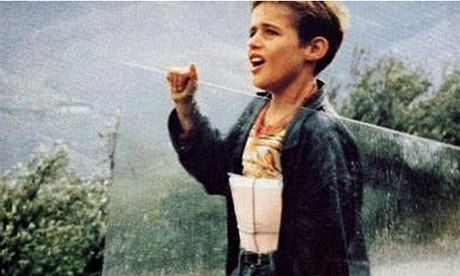 |
| Willow and Wind: a prose-poem of a film. Directed by Mohammad-Ali Talebi, 1999. Courtesy The Guardian |
The most famous fictional character in the world in the last generation was a child, Harry Potter. When the films of JK Rowling's books came to be made, they helped define a new type of CGI fantasy cinema. In the era of the camera phone, children are being filmed more than ever before, by their relatives and friends. A vast digital visual archive of childhood is being created. And yet, in our same era, we are more wary of filming other people's children than ever before. Images of childhood are escapist, multiple, personal and contested.
But beyond the fantasy child, the everywhere child, and the policed image of children, we are living in a golden age of films about children, and haven't quite noticed. Movie directors in Iran, Japan, the UK, Holland and elsewhere are releasing masterpieces about childhood. Why is this golden age happening, and why does it matter?
In the era of the Hollywood studio, child actors like Shirley Temple and Mickey Rooney, both of whom died recently, gave plucky, stylised, showbiz performances. Shooting in a studio, they were surrounded by scores of technicians, large cameras and forests of light stands. Under such circumstances it was hard for a kid to behave naturally. They had to be highly directed, puppeteered almost.
In recent decades, by contrast, the radical miniaturisation of shooting equipment has meant that child performers can be far less intimidated by the movie making process. Of course the Harry Potter movies are still big studio production numbers, but in smaller budget movies, children can be filmed anywhere, with few people behind the camera and no light blasting them. As a result of this, child performances in films like Clio Barnard's recent The Selfish Giant have become more honest; young characters have more agency than at almost any other time in the history of the movies. Children are ad-libbing in front of the camera more, and, in a string of masterpieces made in Iran, improvising. In this golden age of children's cinema, the movies feel as if they are being co-directed by the child and the filmmakers.
To show and celebrate this plenitude, I've programmed The Cinema of Childhood, a season of seventeen films from around the world, which will screen cinemas UK-wide from 11 April. We've got three extraordinary films by Mohammad-Ali Talebi, in which the Iranian director, who will visit the UK for the first time for the screenings, sends his pre-teen characters on journeys as complex as Cary Grant's in Alfred Hitchcock's North by Northwest. In Willow and Wind, The Boot and Bag of Rice we see childhood fortitude and daring, as well as those shocking moments when a child strays into danger without knowing it. Talebi's work has grace and grandeur. He's one of the world's best filmmakers.
Also in the season is a stunning Polish film, Crows, directed by Dorota Kedzierzawska, in which a little girl steals an even smaller girl and they run to the sea. The thief is understimulated, so she walks on the wild side. The recent Japanese films of Hirokazu Kore-eda - in particular I Wish and Nobody Knows - have been acclaimed and deeply moving portraits of semi-alone kids in cities, who form families of their own. The best Japanese film that we are showing is Moving, by Shinji Somai, which is from slightly further back but whose gorgeous visuals and swelling emotions make us feel that we are seeing childhood anew.
Cinema of Childhood has recent examples of great movies about children, but it also looks backwards to see where this golden age came from. In Britain, of course, Ken Loach's still fresh Kes set a high water mark. We're showing a gorgeous Japanese film from the 1930s, Children in the Wind, in which a boy seems like father to a man, and a short movie, Palle Alone in the World, by one of the world's best directors of children, Astrid Henning-Jensen. Also, from America, we're screening Little Fugitive, a raw, vivid and tender movie about a boy who thinks that he has killed his brother, so runs away to a fun fair.
The revelation comes from recognition - that we are seeing through the eyes of the children themselves. These films matter, and are amongst the best in the world, because they show universal things: curiosity, uncensored thinking, surrealism and the process of attaching, of caring about the world outside ourselves.
Cinema is an empathy machine. The films we are showing are adventures, embraces.
Via The Huffington Post

No comments:
Post a Comment